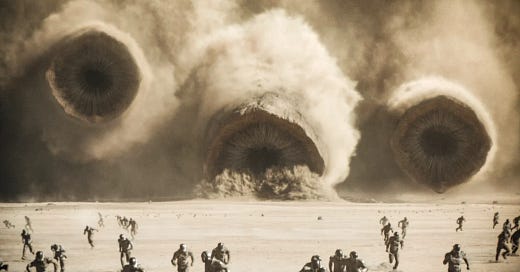“Sound is at the heart of the cinematic experience” - Denis Villeneuve
Dune: Part Two is undoubtedly my favourite movie to have come out this year. In fact, it might be my favourite movie, period. It’s seldom that I watch a movie more than once in cinema: I watched this one three times. My first rewatch of Dune: Part Two was the first time that I had the chance to experience a movie in iMax and I was blown away by the quality of the picture, as well as the incredibly sound system. I found the sound design and score of this movie incredible and wanted to learn everything about how the sound team brought the world of Dune to life.
“Everything should sound natural…” - Mark Mangini
The desire of the director was to create a visual environment that looked as familiar as possible to audiences to inspire relatability between the natural environments created through the movie and real world environments. This left it up to sound and score to transport the viewer into a psychedelic science-fiction experience. Denis Villeneuve’s respect for the sound design was reflected in the methods of creation: typically sound design for film is a process reserved as part of the post-production, but with Dune, the team was involved in the production process from conception. This gave the director the opportunity to shape the sound of the Dune universe throughout the production process. This also afforded the sound production team – Mark Mangini (Sound Designer), Theo Green (Sound Editor), Ron Bartlett (Re-Recording Mixer) – much needed time to experiment with different sound design and recording techniques.
In interviews with Warner Brothers (video above), the sound production team discuss how sand plays a massive thematic role in the movie and how beneficial it was to have had the opportunity to study the sounds of the desert early into the process, allowing them to develop an incredibly realistic and immersive experience, given a foundation of incredible understanding of the environment in which the movie is based.
Dune provides many examples of how creative the sound design process can be. My favourite example of this is Mark Mangini sticking a microphone down his throat to record what ended up being the iconic “gunk-gunk” sound of the giant sandworms. This is one of a number of examples of how sound inspired aspects of the visual experience and visual effects process. Other examples of this are the vibratory movements of the giant sandworms, the protective combat suits and most notably the sound of the Bene Gesserit voice which became a major storytelling tool throughout the film.
The use of panning throughout the movie aids in the feeling of immersion, especially in an object-based cinema environment. The delicate sounds of the dessert as well as voices used as effects spinning around the room pull the audience member through the screen and into the Dune universe. If I have the opportunity to watch this film in iMAX or Dolby Cinema in the future, I’ll grab it with both hands.




